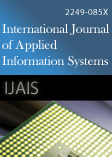
- S. Murugesan and D. Jayaraman and J. Shiama 2013. 3-Equitable Prime Cordial Labeling of Graphs. International Journal of Applied Information Systems. 5, 9 (July 2013), 1-4. DOI=http://dx.doi.org/10.5120/ijais450974
-
@article{10.5120/ijais2017451568, author = {S. Murugesan and D. Jayaraman and J. Shiama}, title = {3-Equitable Prime Cordial Labeling of Graphs}, journal = {International Journal of Applied Information Systems}, issue_date = {July 2013}, volume = {5}, number = {}, month = {July}, year = {2013}, issn = {}, pages = {1-4}, numpages = {}, url = {/archives/volume5/number9/506-0974}, doi = { 10.5120/ijais13-450974}, publisher = { xA9 2012 by IJAIS Journal}, address = {} } -
%1 450974 %A S. Murugesan %A D. Jayaraman %A J. Shiama %T 3-Equitable Prime Cordial Labeling of Graphs %J International Journal of Applied Information Systems %@ %V 5 %N %P 1-4 %D 2013 %I xA9 2012 by IJAIS Journal
Abstract
In today's fast pacing computer age where everything is digitized, it is imperative to have simple and efficient mechanisms or algorithms that help in analyzing usage patterns of customers. Such an analysis helps in developing profitable marketing strategies to enhance business and to serve customers better. In this paper, we will be presenting results of a simple counting algorithm [1] as compared to the complex Apriori algorithm [3] in order to find the maximum frequent itemsets. Apriori was first proposed by R. Agrawal et al [4, 5]. Many improved algorithms are based on this algorithm [6, 7]. The tedious scans of the Apriori algorithm for candidate generations will be reduced to a single scan in which the entire database will be stored in a bitmap matrix. Thus, the overhead on the system will be greatly reduced. Results will be obtained in a more quicker and efficient manner. Comparisons between the two techniques will be made in the form of a performance graph in an attempt to highlight the most suitable technique. Conclusions will be made following the advantages and future scope of the implementation.
References
- F. Harary, Graph Theory, Addition-Wesley, Reading, Mass, 1972.
- David M. Burton, Elementary Number Theory, Second Edition,Wm. C. Brown Company Publishers, 1980.
- J. A. Gallian, A dynamic survey of graph labeling, Electronic Journal of Combinatorics, 17 (2010), DS6.
- L. W. Beineke and S. M. Hegde, Strongly multiplicative graphs, Discuss. Math. Graph Theory, 21(2001), 63-75.
- G. S. Bloom and S. W. Golomb, Applications of numbered undirected graphs, Proceedings of IEEE, 165(4)(1977), 562-570.
- I. Cahit, Cordial graphs, A weaker version of graceful and harmonius graphs, Ars Combinatoria, 23(1987), 201-207.
- S. K. Vaidya, G. V. Ghodasara, Sweta Srivastav and V. J. Kaneria, Some new cordial graphs, Int. J. of Math and Math. Sci 4(2)(2008)81-92.
- I. Cahit, On cordial and 3-equitable labeling of graphs, Utilitas Math, 37(1990), 189-198.
- M. Z. Youssef, A necessary condition on k-equitable labelings, Utilitas Math, 64(2003), 193-195.
- M. Sundaram, R. Ponraj and S. Somasundaram, Prime cordial labeling of graphs, Journal of Indian Academy of Mathematics, 27(2005), 373-390.
- S. K. Vaidya and P. L. Vihol , Prime cordial labeling of some graphs, Modern Applied Science, 4(8)(2010), 119-126.
Keywords
3-equitable prime cordial labeling, 3-equitable prime cordial
 10.5120/ijais13-450974
10.5120/ijais13-450974
